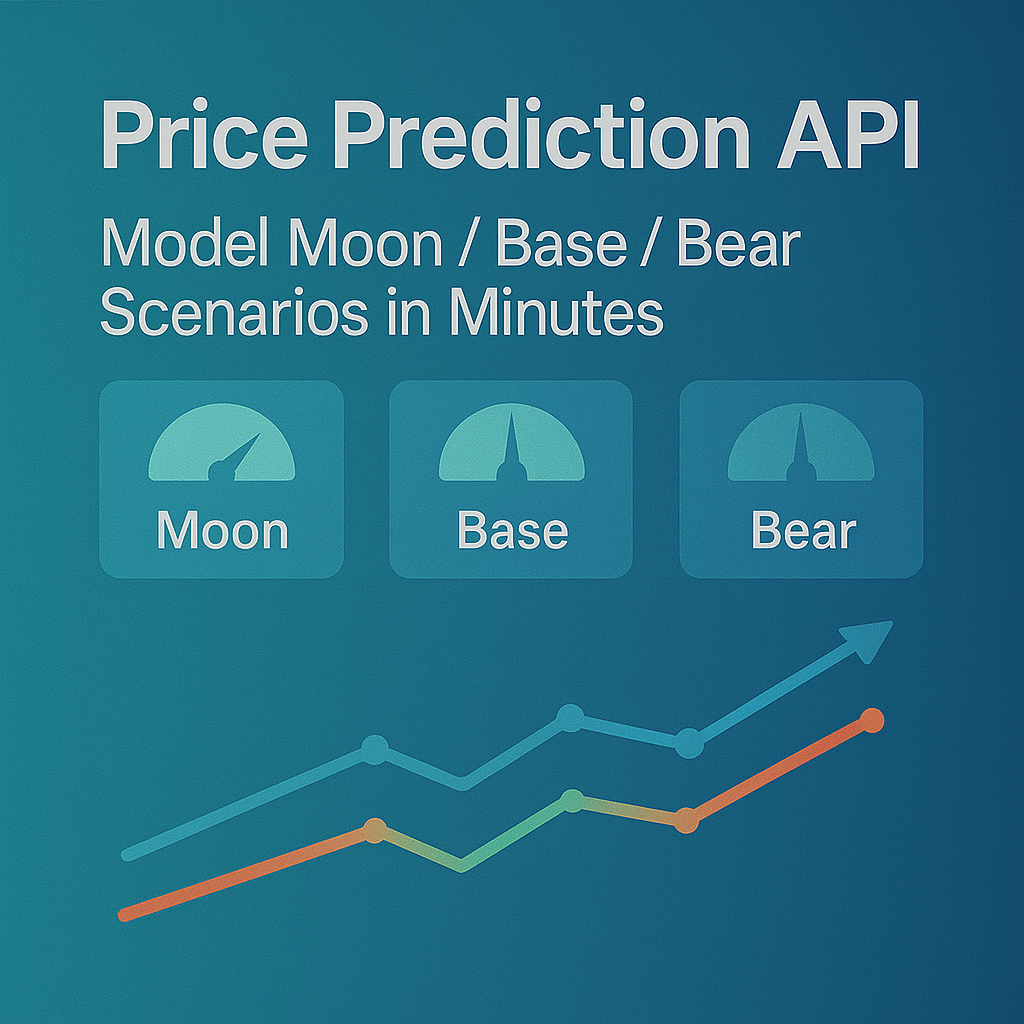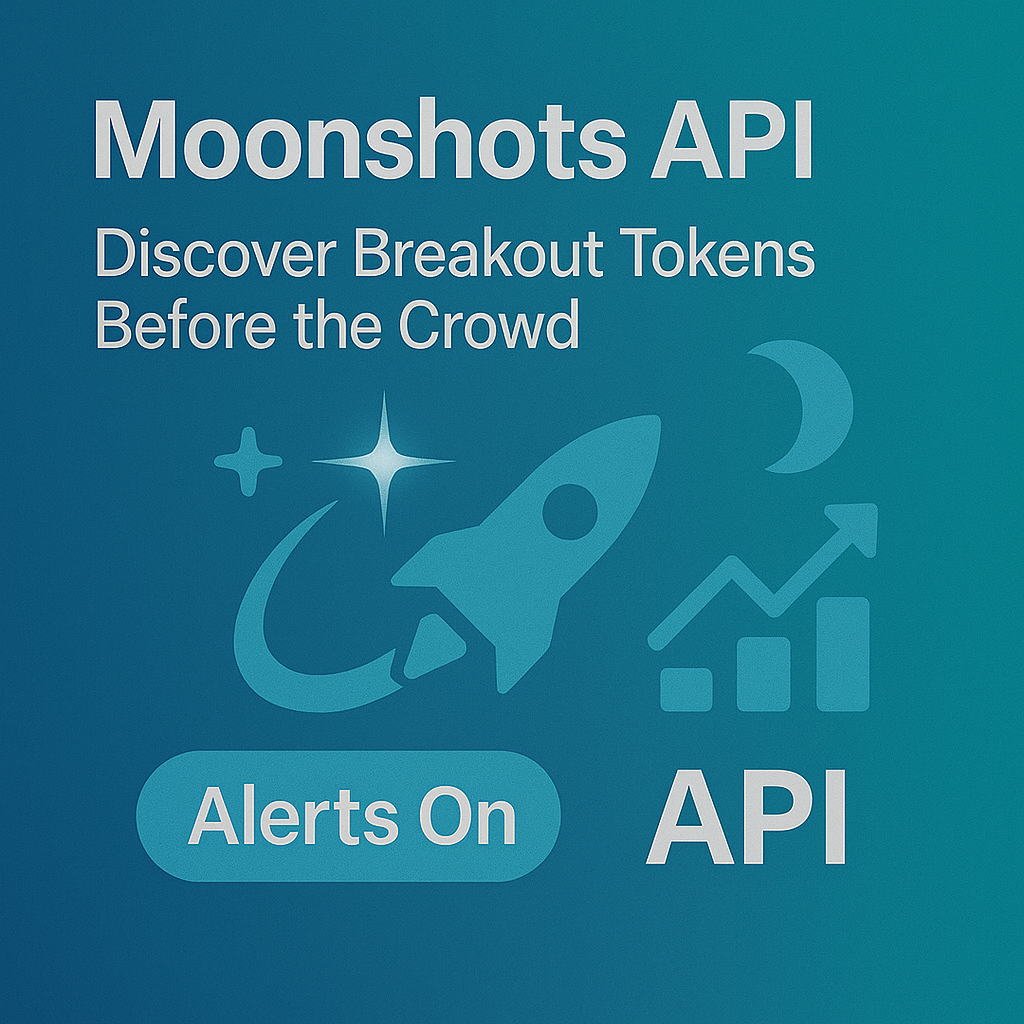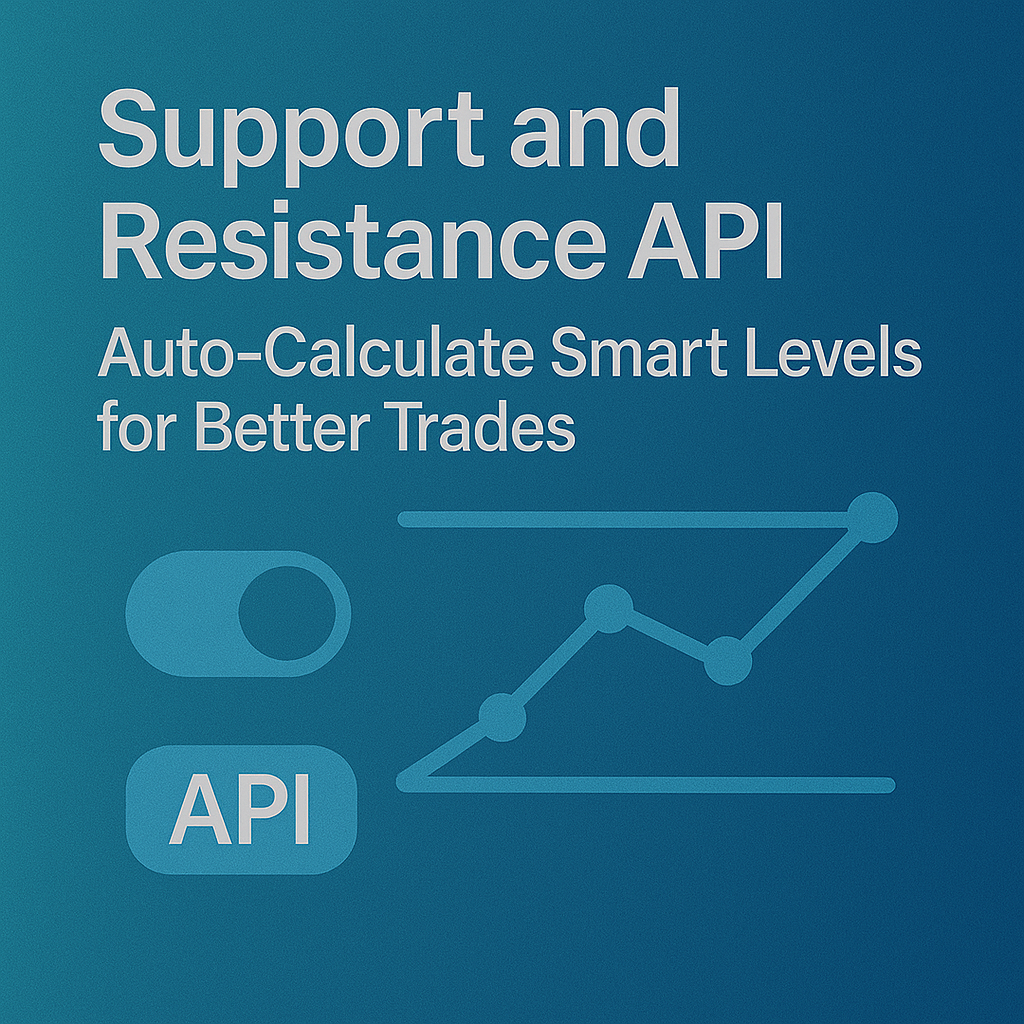Top Crypto Trading Platforms in 2025







%201.svg)
%201.svg)
Big news: We’re cranking up the heat on AI-driven crypto analytics with the launch of the Token Metrics API and our official SDK (Software Development Kit). This isn’t just an upgrade – it's a quantum leap, giving traders, hedge funds, developers, and institutions direct access to cutting-edge market intelligence, trading signals, and predictive analytics.
Crypto markets move fast, and having real-time, AI-powered insights can be the difference between catching the next big trend or getting left behind. Until now, traders and quants have been wrestling with scattered data, delayed reporting, and a lack of truly predictive analytics. Not anymore.
The Token Metrics API delivers 32+ high-performance endpoints packed with powerful AI-driven insights right into your lap, including:
Getting started with the Token Metrics API is simple:
At Token Metrics, we believe data should be decentralized, predictive, and actionable.
The Token Metrics API & SDK bring next-gen AI-powered crypto intelligence to anyone looking to trade smarter, build better, and stay ahead of the curve. With our official SDK, developers can plug these insights into their own trading bots, dashboards, and research tools – no need to reinvent the wheel.
%201.svg)
%201.svg)
The biggest gains in crypto rarely come from the majors. They come from Moonshots—fast-moving tokens with breakout potential. The Moonshots API surfaces these candidates programmatically so you can rank, alert, and act inside your product. In this guide, you’ll call /v2/moonshots, display a high-signal list with TM Grade and Bullish tags, and wire it into bots, dashboards, or screeners in minutes. Start by grabbing your key at Get API Key, then Run Hello-TM and Clone a Template to ship fast.
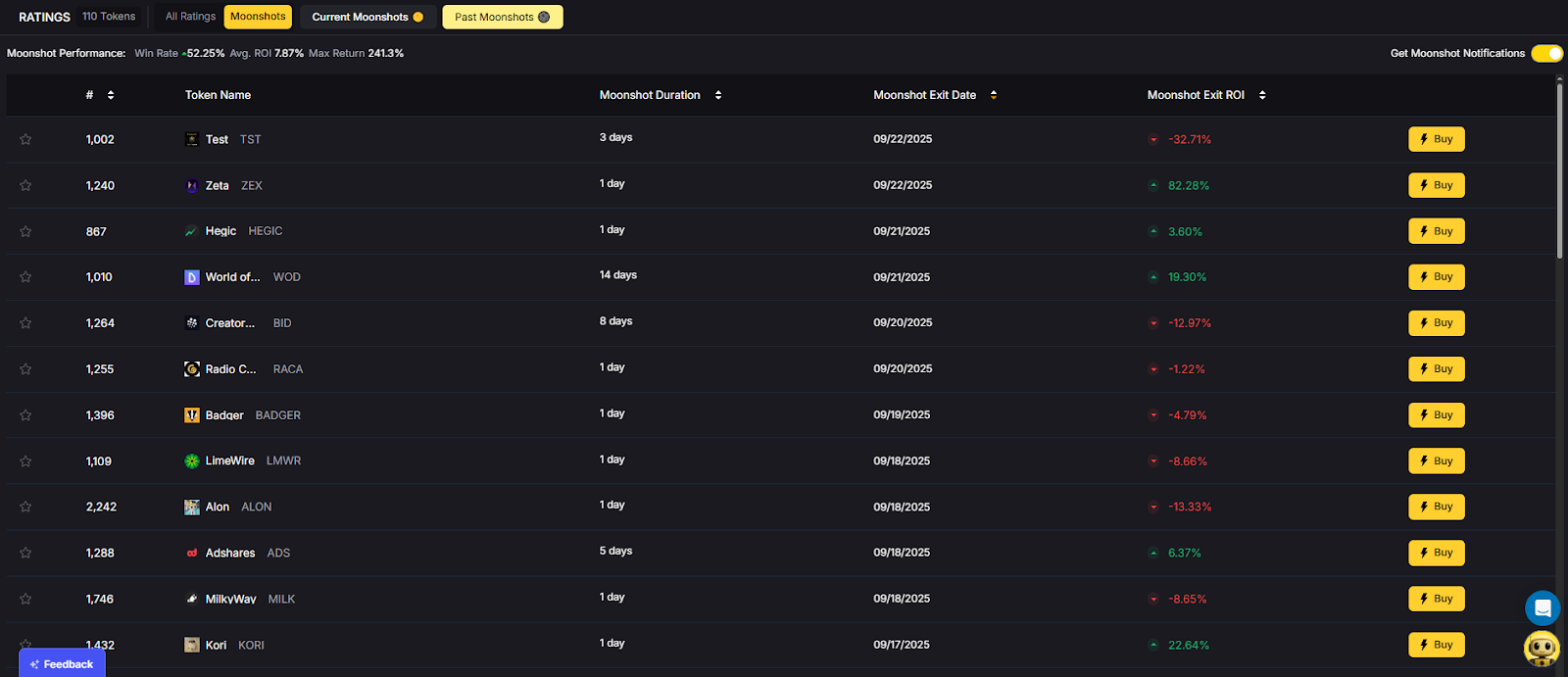
Discovery that converts. Users want more than price tickers—they want a curated, explainable list of high-potential tokens. The moonshots API encapsulates multiple signals into a short list designed for exploration, alerts, and watchlists you can monetize.
Built for builders. The endpoint returns a consistent schema with grade, signal, and context so you can immediately sort, badge, and trigger workflows. With predictable latency and clear filters, you can scale to dashboards, mobile apps, and headless bots without reinventing the discovery pipeline.
The Moonshots API cURL request is right there in the top right of the API Reference. Grab it and start tapping into the potential!
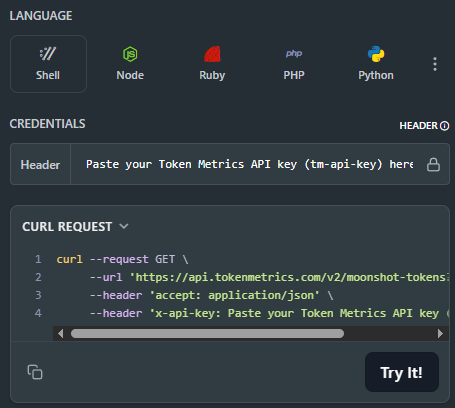
👉 Keep momentum: Get API Key • Run Hello-TM • Clone a Template
Fork a screener or alerting template, plug your key, and deploy. Validate your environment with Hello-TM. When you scale users or need higher limits, compare API plans.
The Moonshots endpoint aggregates a set of evidence—often combining TM Grade, signal state, and momentum/volume context—into a shortlist of breakout candidates. Each row includes a symbol, grade, signal, and timestamp, plus optional reason tags for transparency.
For UX, a common pattern is: headline list → token detail where you render TM Grade (quality), Trading Signals (timing), Support/Resistance (risk placement), Quantmetrics (risk-adjusted performance), and Price Prediction scenarios. This lets users understand why a token was flagged and how to act with risk controls.
Polling vs webhooks. Dashboards typically poll with short-TTL caching. Alerting flows use scheduled jobs or webhooks (where available) to smooth traffic and avoid duplicates. Always make notifications idempotent.
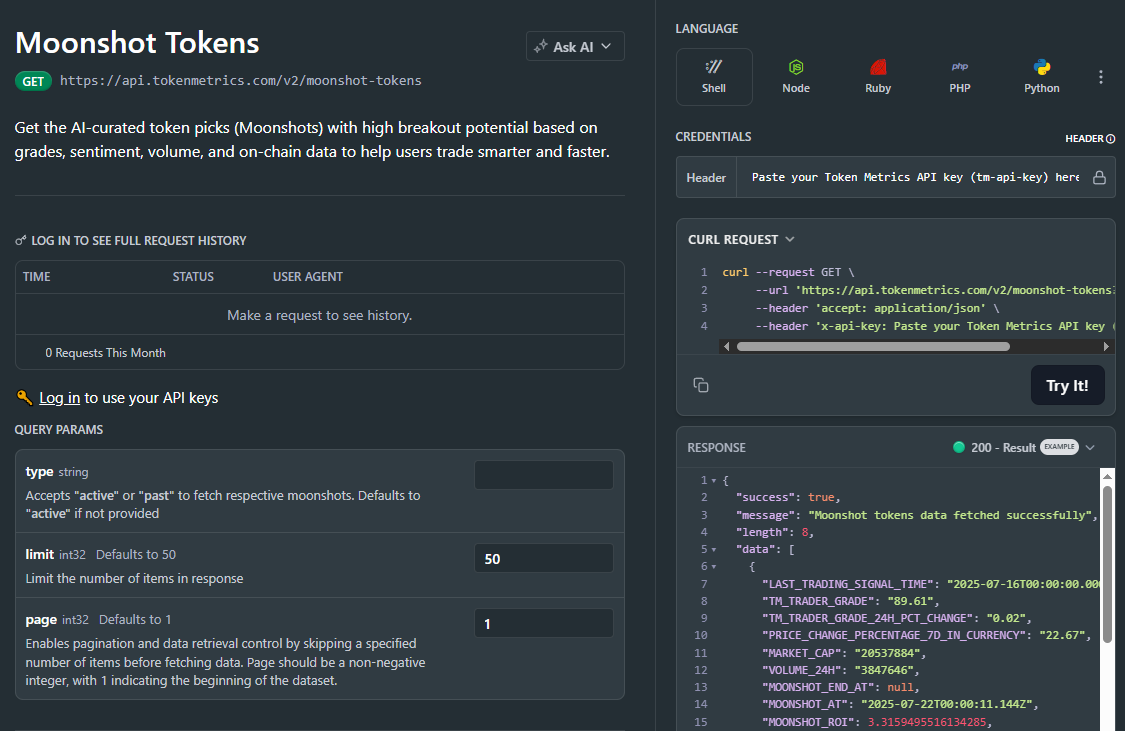
1) What does the Moonshots API return?
A list of breakout candidates with fields such as symbol, tm_grade, signal (often Bullish/Bearish), optional reason tags, and updated_at. Use it to drive discover tabs, alerts, and watchlists.
2) How fresh is the list? What about latency/SLOs?
The endpoint targets predictable latency and timely updates for dashboards and alerts. Use short-TTL caching and queued jobs/webhooks to avoid bursty polling.
3) How do I use Moonshots in a trading workflow?
Common stack: Moonshots for discovery, Trading Signals for timing, Support/Resistance for SL/TP, Quantmetrics for sizing, and Price Prediction for scenario context. Always backtest and paper-trade first.
4) I saw results like “+241%” and a “7.5% average return.” Are these guaranteed?
No. Any historical results are illustrative and not guarantees of future performance. Markets are risky; use risk management and testing.
5) Can I filter the Moonshots list?
Yes—pass parameters like min_grade, signal, and limit (as supported) to tailor to your audience and keep pages fast.
6) Do you provide SDKs or examples?
REST works with JavaScript and Python snippets above. Docs include quickstarts, Postman collections, and templates—start with Run Hello-TM.
7) Pricing, limits, and enterprise SLAs?
Begin free and scale up. See API plans for rate limits and enterprise options.
%201.svg)
%201.svg)
Most traders still draw lines by hand in TradingView. The support and resistance API from Token Metrics auto-calculates clean support and resistance levels from one request, so your dashboard, bot, or alerts can react instantly. In minutes, you’ll call /v2/resistance-support, render actionable levels for any token, and wire them into stops, targets, or notifications. Start by grabbing your key on Get API Key, then Run Hello-TM and Clone a Template to ship a production-ready feature fast.
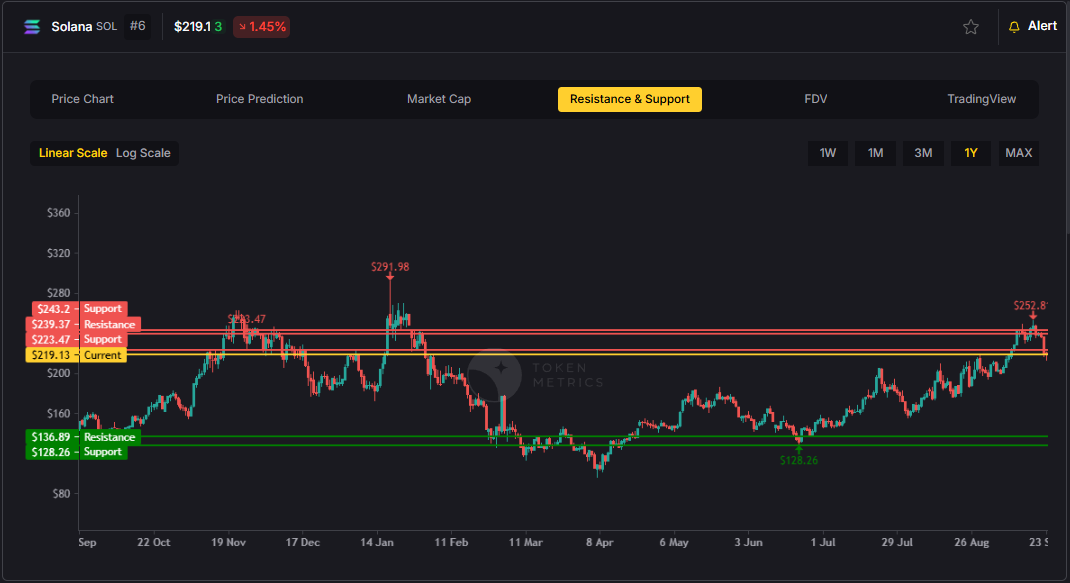
Precision beats guesswork. Hand-drawn lines are subjective and slow. The support and resistance API standardizes levels across assets and timeframes, enabling deterministic stops and take-profits your users (and bots) can trust.
Production-ready by design. A simple REST shape, predictable latency, and clear semantics let you add levels to token pages, automate SL/TP alerts, and build rule-based execution with minimal glue code.
Need the Support and Resistance data? The cURL request for it is in the top right of the API Reference for quick access.
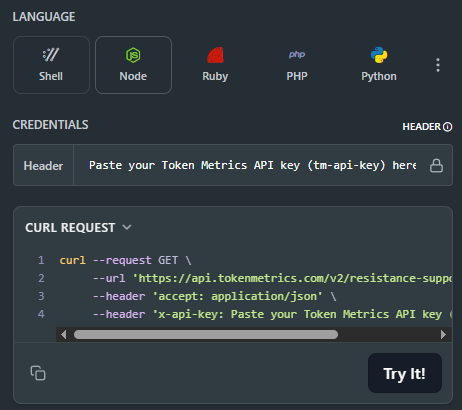
👉 Keep momentum: Get API Key • Run Hello-TM • Clone a Template
Kick off with our quickstarts—fork a bot or dashboard template, plug your key, and deploy. Confirm your environment by Running Hello-TM. When you’re scaling or need webhooks/limits, review API plans.
The Support/Resistance endpoint analyzes recent price structure to produce discrete levels above and below current price, along with strength indicators you can use for priority and styling. Query /v2/resistance-support?symbol=<ASSET>&timeframe=<HORIZON> to receive arrays of level objects and timestamps.
Polling vs webhooks. For dashboards, short-TTL caching and batched fetches keep pages snappy. For bots and alerts, use queued jobs or webhooks (where applicable) to avoid noisy, bursty polling—especially around market opens and major events.
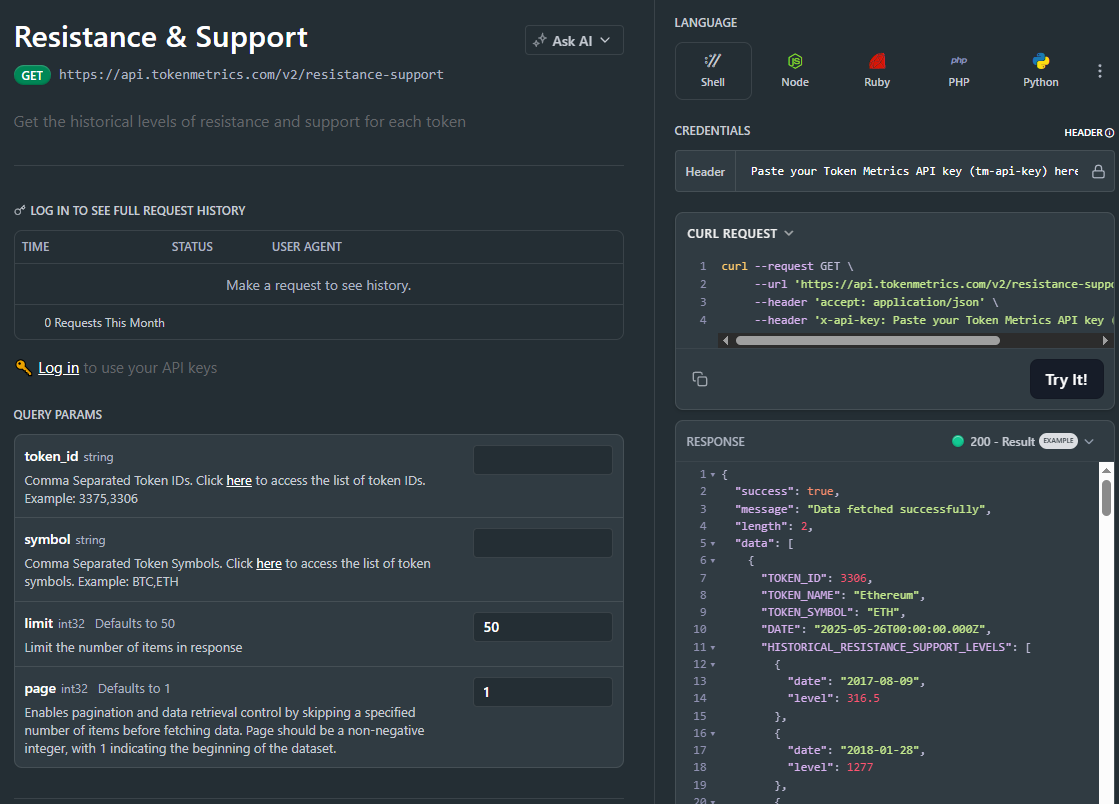
1) What does the Support & Resistance API return?
A JSON payload with arrays of support and resistance levels for a symbol (and optional timeframe), each with a price and strength indicator, plus an update timestamp.
2) How timely are the levels? What are the latency/SLOs?
The endpoint targets predictable latency suitable for dashboards and alerts. Use short-TTL caching for UIs, and queued jobs or webhooks for alerting to smooth traffic.
3) How do I trigger alerts or trades from levels?
Common patterns: alert when price is within X% of a level, touches a level, or breaks beyond with confirmation. Always make downstream actions idempotent and respect rate limits.
4) Can I combine levels with other endpoints?
Yes—pair with /v2/trading-signals for timing, /v2/tm-grade for quality context, and /v2/quantmetrics for risk sizing. This yields a complete decide-plan-execute loop.
5) Which timeframe should I use?
Intraday bots prefer shorter horizons; swing/position dashboards use daily or higher-timeframe levels. Offer a timeframe toggle and cache results per setting.
6) Do you provide SDKs or examples?
Use the REST snippets above (JS/Python). The docs include quickstarts, Postman collections, and templates—start with Run Hello-TM.
7) Pricing, limits, and enterprise SLAs?
Begin free and scale as you grow. See API plans for rate limits and enterprise SLA options.
%201.svg)
%201.svg)
Most traders see price—quants see probabilities. The Quantmetrics API turns raw performance into risk-adjusted stats like Sharpe, Sortino, volatility, drawdown, and CAGR so you can compare tokens objectively and build smarter bots and dashboards. In minutes, you’ll query /v2/quantmetrics, render a clear performance snapshot, and ship a feature that customers trust. Start by grabbing your key at Get API Key, Run Hello-TM to verify your first call, then Clone a Template to go live fast.
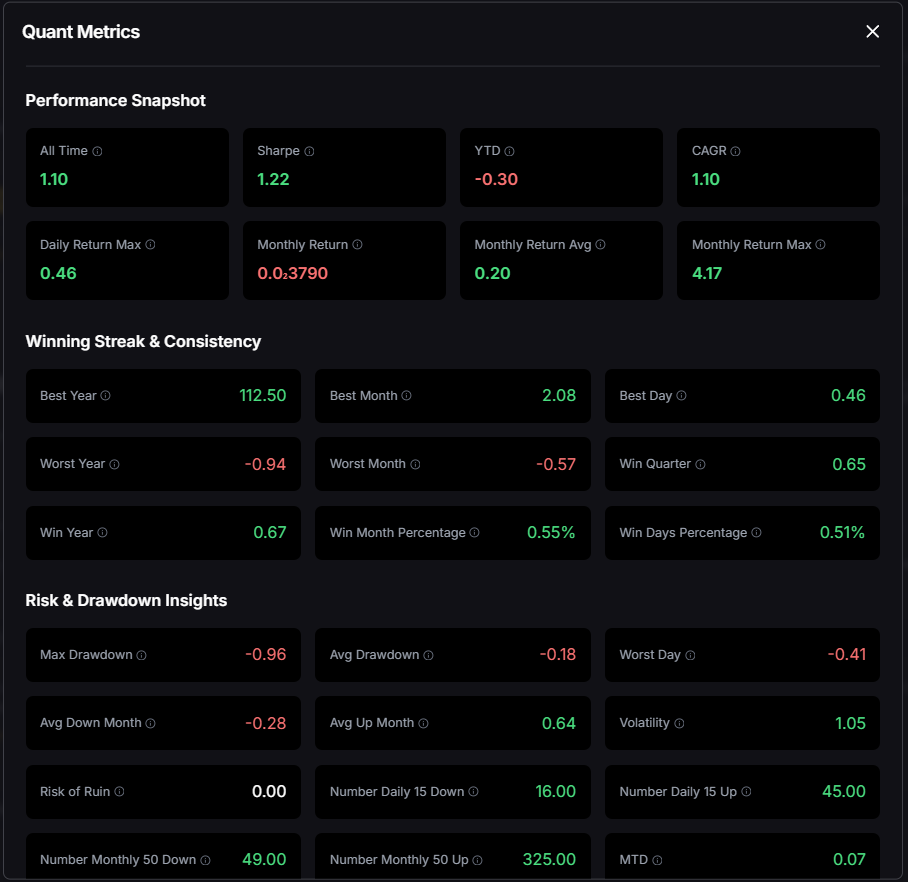
Risk-adjusted truth beats hype. Price alone hides tail risk and whipsaws. Quantmetrics compresses edge, risk, and consistency into metrics that travel across assets and timeframes—so you can rank universes, size positions, and communicate performance like a pro.
Built for dev speed. A clean REST schema, predictable latency, and easy auth mean you can plug Sharpe/Sortino into bots, dashboards, and screeners without maintaining your own analytics pipeline. Pair with caching and batching to serve fast pages at scale.
The Quant Metrics cURL request is located in the top right of the API Reference, allowing you to easily integrate it with your application.
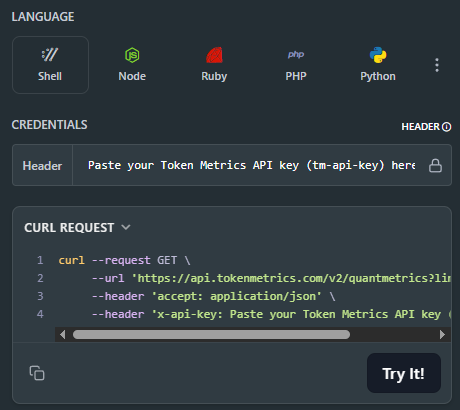
👉 Keep momentum: Get API Key • Run Hello-TM • Clone a Template
Kick off from quickstarts in the docs—fork a dashboard or screener template, plug your key, and deploy in minutes. Validate your environment with Run Hello-TM; when you need more throughput or webhooks, compare API plans.
Quantmetrics computes risk-adjusted performance over a chosen lookback (e.g., 30d, 90d, 1y). You’ll receive a JSON snapshot with core statistics:
Call /v2/quantmetrics?symbol=<ASSET>&window=<LOOKBACK> to fetch the current snapshot. For dashboards spanning many tokens, batch symbols and apply short-TTL caching. If you generate alerts (e.g., “Sharpe crossed 1.5”), run a scheduled job and queue notifications to avoid bursty polling.
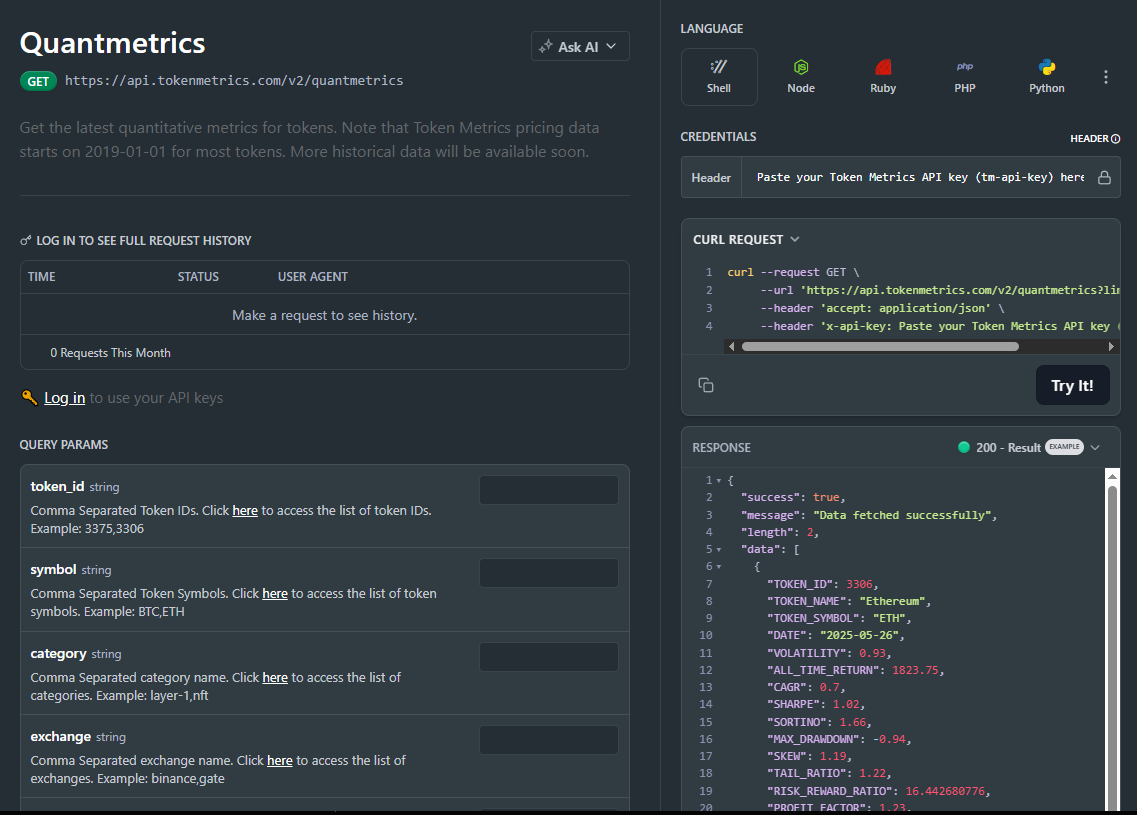
1) What does the Quantmetrics API return?
A JSON snapshot of risk-adjusted metrics (e.g., Sharpe, Sortino, volatility, max drawdown, CAGR) for a symbol and lookback window—ideal for ranking, sizing, and dashboards.
2) How fresh are the stats? What about latency/SLOs?
Responses are engineered for predictable latency. For heavy UI usage, add short-TTL caching and batch requests; for alerts, use scheduled jobs or webhooks where available.
3) Can I use Quantmetrics to size positions in a live bot?
Yes—many quants size inversely to volatility or require Sharpe ≥ X to trade. Always backtest and paper-trade before going live; past results are illustrative, not guarantees.
4) Which lookback window should I choose?
Short windows (30–90d) adapt faster but are noisier; longer windows (6–12m) are steadier but slower to react. Offer users a toggle and cache each window.
5) Do you provide SDKs or examples?
REST is straightforward (JS/Python above). Docs include quickstarts, Postman collections, and templates—start with Run Hello-TM.
6) Polling vs webhooks for quant alerts?
Dashboards usually use cached polling. For threshold alerts (e.g., Sharpe crosses 1.0), run scheduled jobs and queue notifications to keep usage smooth and idempotent.
7) Pricing, limits, and enterprise SLAs?
Begin free and scale up. See API plans for rate limits and enterprise SLA options.

%201.svg)
%201.svg)
API keys are a critical part of modern application development—enabling powerful third-party integrations while also presenting potential security risks. As APIs become the backbone of fintech, crypto, AI, and data applications, developers must ask: what are the safest and most scalable ways to store and access API keys? Let’s explore essential strategies, tools, and risks when handling sensitive API credentials.
API keys function like digital passports, granting your application access to valuable services—from price feeds and SMS messaging to trading platforms and blockchain analytics. An exposed API key can lead to data leaks, unauthorized transactions, inflated bills, or even broader system compromise. High-profile data breaches, such as those resulting from public code repositories exposing secrets, underline the real-world impact of poor API key management.
Moreover, regulations and best practices in the crypto and AI industries demand robust security measures. Protecting API keys is not just about your own infrastructure—it’s about the trust your users and partners have in your platform.
Many security mishaps stem from common mistakes that are easy to avoid with the right protocols. These include:
Avoiding these pitfalls is a foundational step in API key security, but more sophisticated controls are often necessary as your application scales.
To shield your API keys from breach and misuse, modern applications should utilize several technical best practices and tools:
Additionally, always use least privilege principles: grant API keys only the permissions required for specific actions, and leverage IP allowlists or referrer checks where supported by the API provider.
How your application retrieves and uses API keys can be just as important as where they’re stored. Consider these approaches:
Developers can further reduce risk by implementing rate limiting, automated key revocation/rotation, and zero trust policies—especially in large-scale or multi-developer environments.
Choosing the right tools can simplify and strengthen your API key security model. Some popular frameworks and services include:
When connecting to crypto or AI services via API—such as Token Metrics—these tools make safe integration straightforward while maintaining regulatory compliance and auditability.
Build Smarter Crypto Apps & AI Agents with Token Metrics
Token Metrics provides real-time prices, trading signals, and on-chain insights all from one powerful API. Grab a Free API Key
If an API key is leaked, attackers could exploit your account to perform unauthorized transactions, scrape data, or exhaust your API limits. It’s essential to immediately revoke and regenerate compromised keys, audit usage, and identify the exposure vector.
No. Always generate separate API keys for each environment. This limits the impact of a potential leak and helps with auditing and troubleshooting.
Only if the keys are encrypted at rest and the database access is strictly controlled. Prefer specialized secrets managers over general-purpose databases for handling sensitive keys.
Regular key rotation reduces risk from undetected exposures. The frequency depends on the sensitivity of the APIs in use—critical infrastructure often rotates every 90 days or less. Always rotate keys after a possible leak.
Share only through secure, auditable channels and never through unsecured messaging or docs. Use role-based permissions so each person has only the access they need, and revoke keys if team members leave.
This content is provided for educational and informational purposes only. It does not constitute software security advice or an offer to buy or sell any financial product. Always perform your own due diligence and consult with appropriate professionals before implementing sensitive system changes.
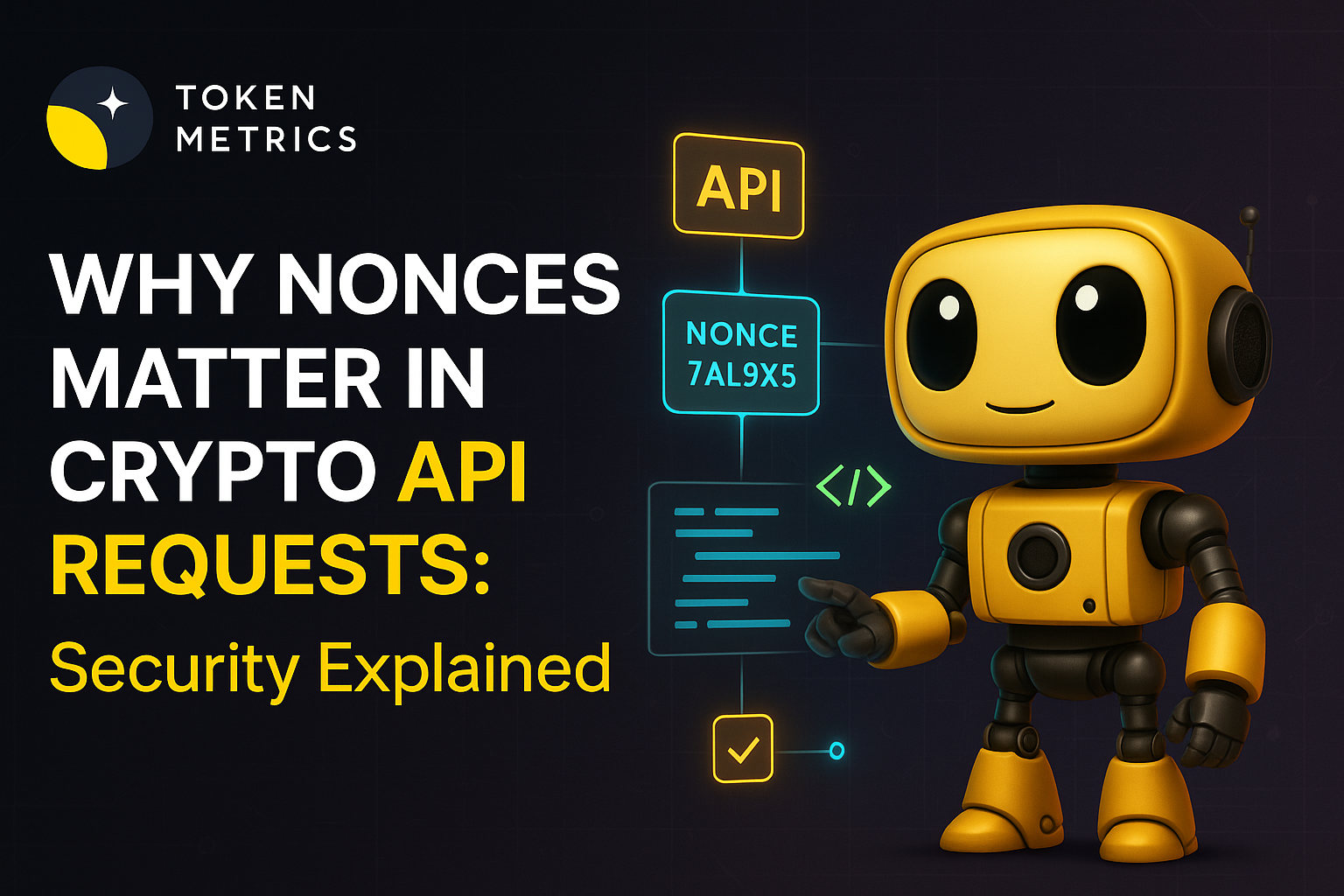
%201.svg)
%201.svg)
Every second, millions of API requests zip across the crypto ecosystem. From automated trading bots to portfolio trackers, these requests are the lifeblood of decentralized finance and digital asset management. But what stops attackers from copying—or replaying—old requests to manipulate sensitive operations? Enter the ‘nonce’: a small but mighty concept that powers security behind the scenes.
A nonce—short for “number used once”—is a unique value included in every API request sent to a crypto service or exchange. The purpose of a nonce is simple yet vital: it guarantees that each request is unique and can’t be processed more than once.
Think of a nonce as a one-time security token. When a crypto API receives a request (like placing an order or checking your account balance), it checks the nonce. If the same nonce has been seen before, the request is rejected. This prevents ‘replay attacks’ where bad actors try to trick the system by resending (replaying) previous valid requests.
Nonces are especially important in crypto and blockchain applications, where secure, programmatic access is essential and funds or sensitive data are directly at stake.
APIs are gateways for interacting with exchanges, wallets, and on-chain data. Because API requests may initiate financial transactions or access confidential information, security is paramount. Here’s why nonces matter so much in this context:
Practically, if a request using an old or duplicate nonce is sent, it will be denied—even if the signature and other details are correct. This adds a crucial layer of defense for both users and API providers.
Different crypto APIs implement nonces in slightly different ways, but the fundamental principle is the same: no nonce, no action. Here’s how nonces typically function:
For example, suppose you run a crypto trading bot accessing an exchange’s private API. After every successful order, your bot updates the nonce (say, using timestamp or ordering sequence). If it accidentally reuses an old nonce, the server will return an error, ensuring only fresh, intentional actions are completed.
Some exchanges or providers, such as Binance, Kraken, or Token Metrics, may reject entire request batches if a single nonce breaks the expected pattern. This underscores the need for careful nonce management in automated workflows.
Although nonces dramatically improve security, they’re not foolproof if implemented poorly. The most common risks and solutions include:
For enhanced protection, always combine nonces with API signatures, HTTPS communication, and well-managed API keys. Audit and monitor account activity through your provider’s dashboard or automated alerts.
AI-powered crypto bots, trading apps, and research agents depend on secure and reliable APIs. Nonces are foundational to these security practices. Reliable nonce management ensures that sophisticated models can safely execute trades, access real-time data, and manage assets without interruption or vulnerability to replay fraud.
For teams building custom AI agents or analytics dashboards integrating with multiple crypto exchanges and data vendors, establishing a robust nonce strategy is as important as optimizing trading algorithms. Without it, even the most advanced AI workflows could be compromised by something as simple as a replayed API request.
Build Smarter Crypto Apps & AI Agents with Token Metrics
Token Metrics provides real-time prices, trading signals, and on-chain insights all from one powerful API. Grab a Free API Key
A nonce is a number or unique value included with each crypto API request to guarantee the request’s uniqueness and prevent replay attacks. Without a unique nonce, malicious actors could potentially resend old API requests to repeat previous transactions.
Most APIs accept an incrementing counter, a high-precision timestamp, or a cryptographically-random UUID as a nonce. Always check your provider’s documentation to determine the required format and update your nonce on every request.
If a nonce is reused, the API will typically reject the entire request to prevent accidental or malicious actions from being repeated. Reuse can interrupt automated workflows and, if not handled, introduce vulnerabilities.
No. Nonces should be specific to each API and user session. Even APIs on the same platform may expect unique nonces, and reusing nonces across systems can lead to synchronization errors and rejected requests.
Digital signatures authenticate the origin and integrity of data, but they don’t prevent replay attacks on their own. A nonce, combined with a signature, ensures that even a perfectly signed old request cannot be reused—sharpening your security.
This material is for informational and educational purposes only. It does not constitute financial, investment, or regulatory advice. Please consult official documentation and relevant experts before integrating any security or API best practices. Token Metrics is referenced here as an educational resource only.
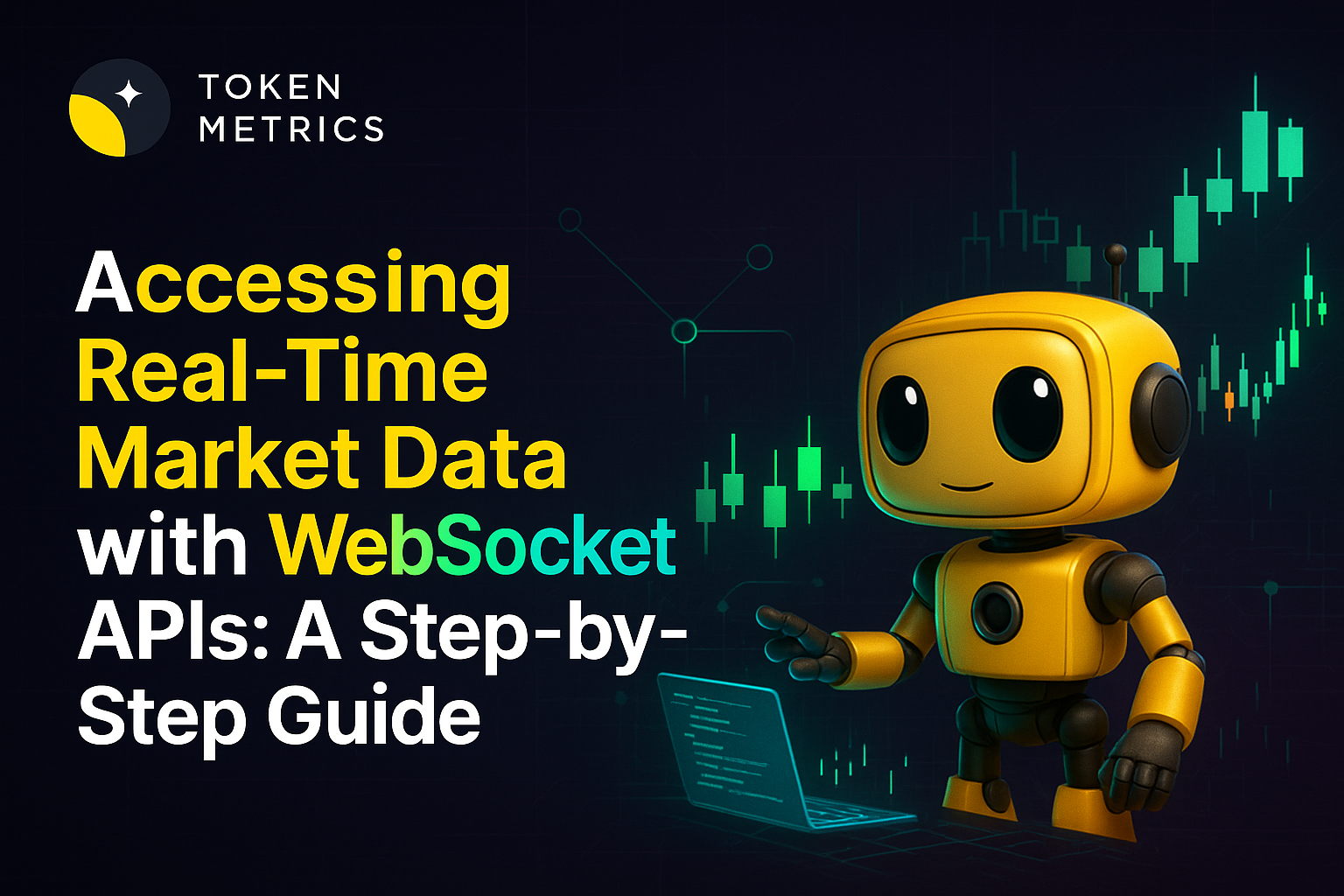
%201.svg)
%201.svg)
Imagine being able to monitor price changes, trades, and order books as they happen—delivered straight to your application or dashboard, with minimal latency. For traders, developers, and analysts, accessing real-time market data can bring tremendous technical and strategic advantages. The secret weapon? Subscribing to WebSocket feeds directly from exchanges or crypto data providers.
WebSockets are a modern web technology that enables full-duplex, bi-directional communication between a client and a server over a single, persistent connection. Unlike conventional HTTP requests—which require continuous polling for new data—WebSockets allow servers to push timely data updates instantly to clients.
This makes WebSockets ideal for streaming live financial data such as ticker prices, trade events, and order book movements. In volatile markets like cryptocurrencies, seconds matter, and having access to real-time updates can provide a more accurate market snapshot than delayed REST API queries. Most major exchanges and crypto data providers—such as Binance, Coinbase, and Token Metrics—offer WebSocket APIs precisely to cater to these real-time scenarios.
Subscribing to real-time market data via WebSocket typically involves the following fundamental steps:
wss://stream.example.com/ws).Here's a simplified example (in Python, using the websockets library) to subscribe to BTC/USD ticker updates on a typical crypto exchange:
import asyncio
import websockets
import json
async def listen():
url = 'wss://exchange.com/ws'
async with websockets.connect(url) as ws:
subscribe_msg = {
"type": "subscribe",
"channels": ["ticker_btcusd"]
}
await ws.send(json.dumps(subscribe_msg))
while True:
msg = await ws.recv()
print(json.loads(msg))
asyncio.get_event_loop().run_until_complete(listen())
Most exchanges have detailed WebSocket API documentation specifying endpoints, authentication, message formats, and available data channels.
The crypto industry offers a broad range of WebSocket APIs, provided either directly by trading venues or specialized third-party data aggregators. Here are important selection criteria and considerations:
Some popular choices for crypto market data WebSocket APIs include:
Subscribing to live market data via WebSocket fuels a wide range of applications across the crypto and finance sectors. Some of the most prominent scenarios include:
Building a production-grade system to consume real-time feeds goes beyond simply opening a socket. Here are practical best practices:
Following these guidelines ensures a robust and resilient real-time data pipeline, a foundation for reliable crypto analytics and applications.
Build Smarter Crypto Apps & AI Agents with Token Metrics
Token Metrics provides real-time prices, trading signals, and on-chain insights all from one powerful API. Grab a Free API Key
Most crypto WebSocket APIs allow subscriptions to real-time trades, price tickers, full order books (level 2/3), candlestick updates, and often even on-chain events. The precise channels and data fields depend on the provider's documentation.
WebSocket market data is generally lower-latency because updates are pushed immediately as market events occur, rather than polled at intervals. This leads to both more timely and often more granular data. For most trading, analytics, or alerting use-cases, WebSocket is preferred over REST for live feeds.
Not always. Public endpoints (such as price tickers or trades) are often accessible without authentication, while premium or private user data (like order management or account positions) will require an API key or token. Always review the provider's authentication requirements and security best practices.
Reliability varies by provider. Leading exchanges like Binance and Coinbase provide extensive documentation and global infrastructure. Aggregated services like the Token Metrics API combine cross-exchange data with analytics and on-chain insights, making them valuable for research and AI-driven crypto tools.
AI-driven analytics layer additional value onto live data streams—for example, detecting anomalous volume, recognizing patterns across exchanges, or issuing smart alerts. Platforms like Token Metrics offer machine learning-powered signals and research, streamlining complex analysis on live feeds for professional and retail users alike.
This article is for informational and educational purposes only. It does not constitute investment advice, financial recommendation, or an offer to buy or sell any assets. Please consult official documentation and do your own research when integrating with APIs or handling sensitive financial data.

%201.svg)
%201.svg)
Managing large volumes of blockchain transaction data is a common challenge for developers building crypto dashboards, on-chain analytics tools, or AI applications. Most APIs limit responses to prevent server overload, making pagination the default when listing all transactions. But how can you reliably and efficiently gather complete transaction histories? Let’s dive into proven strategies for handling paginated API responses.
APIs often implement pagination to break up large datasets—such as transaction histories—into manageable portions. When requesting transaction data, instead of receiving thousands of records in one call (which could strain bandwidth or lead to timeouts), the API returns a subset (a "page") and instructions for fetching subsequent pages.
Each method affects performance, reliability, and implementation details. Understanding which your API uses is the first step to robust transaction retrieval.
Every API is unique—some allow only cursor-based access, while others support limit/offset or even page numbering. Choosing the right approach hinges on your project’s requirements and the API provider’s documentation. For crypto transaction logs or on-chain data:
For example, the Token Metrics API leverages pagination to ensure large data requests (such as all transactions for a wallet) remain consistent and performant.
To list all transactions efficiently, adhere to these best practices:
Below is a generic pseudocode example for cursor-based pagination:
results = []
cursor = None
while True:
response = api.get_transactions(cursor=cursor)
results.extend(response['transactions'])
if not response['next_cursor']:
break
cursor = response['next_cursor']
This approach ensures completeness and flexibility, even for large or frequently-updated transaction lists.
For large portfolios, trading bots, or AI agents analyzing multi-chain transactions, efficiently handling paginated API responses is critical. Considerations include:
When fetching transaction data, always practice security hygiene:
Systematically checking for data consistency between pages helps ensure you don’t miss or double-count transactions—a key concern for compliance and reporting analytics.
Build Smarter Crypto Apps & AI Agents with Token Metrics
Token Metrics provides real-time prices, trading signals, and on-chain insights all from one powerful API. Grab a Free API Key
Pagination is the process of breaking up a large dataset returned by an API into smaller segments, called pages. This practice prevents bandwidth issues and server overload, improving response times and reliability when dealing with extensive data sets such as blockchain transactions.
Cursor-based pagination is typically best for live or evolving datasets like blockchain transactions, as it’s less prone to data inconsistency and works well with rapid updates. However, always follow your chosen API’s recommendations for optimal performance.
Always implement data de-duplication by tracking unique transaction IDs. Carefully handle cursors or offsets, and consider double-checking against expected transaction counts or hashes for reliability.
This depends on the API's capabilities. Some APIs allow multi-address querying, while others require paginated requests per address. When retrieving multiple lists in parallel, monitor rate limits and system memory usage.
Efficient handling of paginated responses ensures complete, timely transaction histories—empowering AI-driven analytics tools to perform advanced analysis, detect patterns, and automate compliance tasks without missing critical data.
This blog post is for informational and educational purposes only. Nothing herein constitutes investment advice or an offer to buy or sell any asset. Please consult relevant documentation and a qualified professional before building production systems.

%201.svg)
%201.svg)
APIs are the backbone of most crypto applications, delivering vital real-time market prices, on-chain analytics, and network signals. Yet, while integrating a crypto data endpoint is powerful, developers quickly discover a common pain point: API rate limits. Mishandling these constraints can cause data gaps, failed requests, or even temporary bans—potentially compromising user experience or the accuracy of your analytics. Understanding how to manage API rate limits effectively ensures stable, scalable access to critical blockchain information.
API rate limits are enforced restrictions on how many requests a client can send to an endpoint within a defined period—such as 60 requests per minute or 1,000 per day. Crypto data providers implement these limits to maintain their infrastructure stability, prevent abuse, and ensure fair resource allocation for all clients. The most common rate-limiting strategies include:
Unintentional breaches—like a runaway script or a poorly timed batch request—will result in HTTP 429 errors (“Too Many Requests”), potentially leading to temporary blocks. Therefore, proactively understanding rate limits is crucial for both robust integrations and courteous API consumption.
When your app or research tool interacts with a crypto data API, receiving a rate-limit error is an opportunity to optimize, not a dead end. Most reputable API providers, including those specializing in crypto, supplement response headers with usage limits and reset timers. Key signals to watch for:
X-RateLimit-Limit, X-RateLimit-Remaining, and X-RateLimit-Reset. These values tell you your total quota, remaining requests, and when you can send requests again.Building logic into your client to surface or log these errors is essential. This helps in troubleshooting, performance monitoring, and future-proofing your systems as API usage scales.
Efficient handling of API rate limits is key for building dependable crypto apps, trading dashboards, and automated research agents. Here are recommended strategies:
X-RateLimit-Reset time, or show cached info with a ‘refresh’ indicator.These techniques not only ensure consistent access but also demonstrate good API citizenship, which can be crucial if you later negotiate higher access tiers or custom SLAs with a provider.
Providers vary widely in their rate limit policies—public/free APIs typically impose strict quotas, while premium plans offer greater flexibility. When selecting an API for your crypto project, assess:
Regulatory and operational needs can also influence choice—some institutional settings require SLAs or security controls only available on enterprise tiers.
The rise of AI agents and automated research scripts has made dynamic API rate-limit management even more critical. Advanced systems can:
Solutions like Token Metrics combine robust crypto APIs with AI-driven research—offering developers programmable access and insights while simplifying best-practice integration and rate management.
Build Smarter Crypto Apps & AI Agents with Token Metrics
Token Metrics provides real-time prices, trading signals, and on-chain insights all from one powerful API. Grab a Free API Key
If you consistently exceed rate limits, you'll likely receive 429 errors, experience dropped requests, and risk a temporary or permanent ban. Responsible handling is essential for reliable data access.
Attempting to circumvent limits by creating many accounts or cycling IPs is discouraged and may violate API terms of use. It's better to work with providers for a proper upgrade or optimization strategy.
Popular HTTP libraries like Axios (JavaScript), requests (Python), and HTTPX have built-in or community-supported retry/backoff plugins. Check your API ecosystem for recommended middlewares or SDKs supporting rate-limiting logic.
Each provider implements unique quotas: some limit based on IP, API key, or endpoint type, and some support higher throughput via premium plans or batch querying. Always review documentation for specifics.
Yes. Many crypto API services offer tailored plans or enterprise integrations with higher quotas. Proactively communicating your use case helps unlock better terms and ensures ongoing support.
This content is for educational and informational purposes only. It does not constitute investment advice, recommendation, or an offer to buy or sell any financial instrument. Use all APIs and tools in accordance with their terms and applicable regulations.

%201.svg)
%201.svg)
Whether you're building a crypto dashboard, conducting blockchain research, or creating an automated trading bot, access to real-time Bitcoin pricing is essential. But how do developers and data analysts retrieve the current price of Bitcoin from a public crypto API—and what are the key considerations when choosing an API for this purpose?
Crypto APIs—or Application Programming Interfaces—are structured gateways that let apps, bots, or websites communicate seamlessly with live crypto data sources. Instead of manually visiting exchanges or aggregators, an API call instantly delivers Bitcoin's current price in a standardized, machine-readable format. This capability underpins everything from price tickers to advanced algorithmic and AI-driven research tools.
Several types of organizations offer public crypto APIs, including:
Public APIs generally support unauthenticated (no login) endpoints for basic pricing, though many now require an API key for higher request rates and advanced data. Whether you’re a beginner or building a sophisticated AI agent, choosing the right crypto API—and querying it appropriately—is the foundational step.
The most straightforward way to retrieve Bitcoin's current price is to query a reputable crypto API from your application or terminal. Here’s a typical workflow:
https://api.coingecko.com/api/v3/simple/price?ids=bitcoin&vs_currencies=usd{ "bitcoin": { "usd": 43000 } }For more advanced needs, consider APIs offering historical pricing, volume data, or exchange-specific quotes, and always respect each provider’s usage policy.
Let’s look at how you might programmatically retrieve Bitcoin price data using Python and JavaScript. These examples use the free CoinGecko public endpoint, but principles are similar for other providers (including Token Metrics). Remember: Always insert your API key if required and consult the provider's documentation for up-to-date endpoints.
import requests
response = requests.get('https://api.coingecko.com/api/v3/simple/price?ids=bitcoin&vs_currencies=usd')
data = response.json()
print('Bitcoin price in USD:', data['bitcoin']['usd'])fetch('https://api.coingecko.com/api/v3/simple/price?ids=bitcoin&vs_currencies=usd')
.then(res => res.json())
.then(data => console.log('Bitcoin price in USD:', data.bitcoin.usd));For APIs requiring an API key, you typically add it via a header or as part of the URL (e.g., ?apikey=YOUR_API_KEY). Always treat keys securely and avoid sharing them in public code repositories.
Not all crypto APIs are equal: coverage, latency, historical data availability, and advanced analytics vary widely. Here are key factors to evaluate:
For enterprise or analytics-focused use cases, APIs like Token Metrics add value through comprehensive data sets, trading signals, and AI-powered insights, enabling deeper quantitative or on-chain research workflows.
Modern crypto research isn’t just about fetching a price—it’s about contextualizing that price within broader trends. AI and machine learning models, including those powering platforms like Token Metrics, ingest live price feeds, on-chain metrics, social sentiment, and more to provide actionable analytics and deeper market understanding.
For developers and researchers, integrating public crypto price APIs is often the first step in powering:
Choosing an API that delivers not only price, but also analytical data, can accelerate both research and application development.
Build Smarter Crypto Apps & AI Agents with Token Metrics
Token Metrics provides real-time prices, trading signals, and on-chain insights all from one powerful API. Grab a Free API Key
A public crypto API is an interface provided by exchanges or data aggregators that allows users to access cryptocurrency data—such as price, volume, and other metrics—without requiring private access or fees. Some APIs may still require free registration for an API key.
This depends on the provider. Leading APIs typically offer real-time or near real-time data (updated every second), but some aggregate or free APIs may introduce short delays. Always check the documentation for specifics on data freshness.
Yes. Almost all public APIs have rate limits—typically restricting the number of requests per minute or per day. These are put in place to prevent abuse and ensure fair access for all users. Higher limits may be available with paid plans or API keys.
This depends on the API’s terms of service. While many offer free public endpoints, commercial usage may be subject to tighter limits or require a paid plan. Always review the provider’s terms, especially for high-frequency or enterprise use.
Public APIs themselves are generally secure when accessed over HTTPS. However, always protect your API keys, follow provider best practices, and avoid exposing sensitive credentials in public code repositories or front-end codebases.
This article is for informational purposes only. It does not constitute financial advice, recommendations, or endorsements. Always conduct independent research and comply with all applicable laws and API usage terms before integrating third-party data sources.

%201.svg)
%201.svg)
In the digital age, applications constantly interact with each other—whether it's your weather app pulling data from a meteorological server, or a crypto portfolio tracker fetching blockchain prices. The hidden force behind most of these interactions? APIs.
This blog post explores what an API is, how it works, and why APIs are so critical to modern software, including use in crypto and blockchain technologies.
API stands for Application Programming Interface. It acts as a bridge that enables two separate software systems to communicate and share data. Much like a waiter taking your order and delivering food between you and the kitchen, an API relays requests and returns the appropriate responses.
Developers use APIs to simplify the building of software applications. Rather than writing code from scratch, APIs allow developers to pull in data, execute tasks, or access services provided by another app or platform.
APIs operate through a series of requests and responses. The client (usually the application or user interface) sends a request to the server (which hosts the API). The API then handles this request, processes it based on pre-defined rules, and returns a response.
Here’s a simplified breakdown of the process:
Most modern APIs are RESTful (Representational State Transfer) and operate via HTTP protocols. These APIs are platform-agnostic and highly scalable, making them suitable for both web and mobile applications.
APIs are fundamental to the crypto ecosystem because they allow developers to:
Build Smarter Crypto Apps & AI Agents in Minutes, Not Months
Real-time prices, trading signals, and on-chain insights all from one powerful API. Grab a Free API Key
APIs vary based on their purpose and accessibility. It's important to understand the distinctions when designing or integrating them.
In the crypto world, partner APIs are often provided by exchanges, while open APIs are commonly seen on market data aggregator platforms.
Given that APIs provide entry points into systems, security is a top priority. Common best practices include:
Enterprises also use API gateways and management layers to track usage, apply governance policies, and scale efficiently.
The crypto industry is teeming with API-driven applications. Here are a few impactful examples:
Whether for DeFi apps, on-chain research, or Web3 gaming—APIs provide the infrastructure for scaling innovation.
A REST API (Representational State Transfer) is an architectural style that uses HTTP methods (GET, POST, PUT, DELETE) to facilitate communication between systems. It's known for being lightweight, stateless, and scalable.
Trading bots use API integrations to access live market data, monitor trade signals, and execute trades automatically on exchanges based on pre-programmed logic.
APIs can be secure if built with strong authentication, encryption, and rate limiting. However, poor implementation or public exposure without proper security layers can introduce vulnerabilities.
Yes. Many platforms like Token Metrics API offer public APIs to developers. These allow you to access real-time data and integrate core functionalities into your app.
Most modern APIs return data in JSON format due to its readability and ease of use. Some also offer XML or CSV for legacy systems.
This blog post is intended for educational purposes only. It does not constitute investment advice, trading guidance, or an endorsement of any financial instruments. Users should conduct their own due diligence and consult with professionals before making any financial decisions.

%201.svg)
%201.svg)
In today's digital asset ecosystem, Application Programming Interfaces, or APIs, are the unsung heroes enabling everything from cryptocurrency wallets to trading bots. Whether you're a developer building for Web3 or a curious user interested in how your exchange functions, understanding how crypto APIs work is essential
A crypto API is a set of programming instructions and standards that allow software applications to communicate with cryptocurrency services. These services may include wallet functions, price feeds, trading engines, exchange platforms, and blockchain networks. By using a crypto API, developers can automate access to real-time market data or execute trades on behalf of users without manually interacting with each platform.
For instance, the Token Metrics API provides structured access to cryptocurrency ratings, analytics, and other data to help teams build intelligent applications.
There are several categories of APIs in the cryptocurrency landscape, each with different capabilities and use cases:
At their core, crypto APIs operate over internet protocols—typically HTTPS—and return data in JSON or XML formats. When an application makes a request to an API endpoint (a specific URL), the server processes the request, fetches the corresponding data or action, and sends a response back.
For example, a crypto wallet app might call an API endpoint like /v1/account/balance to check a user’s holdings. To ensure security and authorization, many APIs require API keys or OAuth tokens for access. Rate limits are also enforced to prevent server overload.
Behind the scenes, these APIs interface with various backend systems—blockchains, trading engines, or databases—to fulfill each request in real time or near real time.
Crypto APIs are used across a broad spectrum of applications:
APIs dramatically reduce time-to-market for developers while enhancing user experience and application efficiency.
When integrating a crypto API, consider the following factors:
Platforms like the Token Metrics API provide both comprehensive documentation and reliability for developers building AI-powered solutions in crypto.
Some of the most powerful crypto APIs now incorporate artificial intelligence and machine learning features. For example, the Token Metrics API facilitates access to predictive models, coin grades, and AI-based price forecasts.
By embedding these tools into custom apps, users can programmatically tap into advanced analytics, helping refine research workflows and support technical or fundamental analysis. Although these outputs can guide decisions, they should be viewed in a broader context instead of relying exclusively on model predictions.
Crypto APIs are critical infrastructure for the entire digital asset industry. From data retrieval and trading automation to blockchain integration and AI-driven analytics, these tools offer immense utility for developers, analysts, and businesses alike. Platforms such as Token Metrics provide not only in-depth crypto research but also API access to empower intelligent applications built on real-time market insights. By understanding how crypto APIs work, users and developers can better navigate the rapidly evolving Web3 landscape.
This article is for informational and educational purposes only. It does not constitute financial, investment, or technical advice. Always conduct your own research and consult professional advisors before making any decisions.

%201.svg)
%201.svg)
The cryptocurrency market operates on a simple, unforgiving principle: timing is everything. While traditional markets sleep, crypto never does. A single tweet, a regulatory announcement, or an AI signal flip can trigger massive price movements within minutes. For most traders, this creates an impossible dilemma – how do you capture every opportunity without becoming a prisoner to your screen?
Today, we're solving that problem forever.
Token Metrics Alerts represents the culmination of years of development and trader feedback. We've built the most sophisticated crypto alert system ever created, designed specifically for the unique challenges of cryptocurrency trading. This isn't just another notification tool – it's your personal market intelligence system.
The core philosophy behind Token Metrics Alerts is simple: empower traders with precise, actionable information delivered exactly when and how they need it. No more, no less.
At the heart of our alert system lies advanced artificial intelligence that continuously analyzes market conditions, price patterns, and trading signals across thousands of cryptocurrencies. When our AI algorithms detect a significant shift – whether bullish or bearish – you're notified instantly.
This AI-driven approach transforms how you interact with market data. Instead of interpreting charts and signals manually, you receive clear, actionable alerts based on sophisticated analysis that would take hours to perform yourself. The AI doesn't sleep, doesn't get emotional, and doesn't miss patterns that human eyes might overlook.
Our AI monitoring includes sentiment analysis, technical pattern recognition, volume analysis, and correlation tracking across multiple timeframes. When these systems converge on a significant signal, that's when you get alerted. It's like having a team of expert analysts working around the clock, exclusively for you.
Token Metrics Alerts recognizes that no two traders are identical. Day traders need different information than long-term holders. Swing traders have different requirements than scalpers. That's why we've built unprecedented customization into every aspect of the alert system.
You can set price movement alerts for any percentage change, whether you want to know about 5% moves or 50% pumps. Custom triggers allow you to monitor specific price levels, support and resistance breaks, or volume spikes. The system adapts to your trading strategy, not the other way around.
The best alert in the world is useless if you don't receive it. Token Metrics Alerts delivers notifications through five distinct channels, each optimized for different scenarios and preferences.
Email alerts provide detailed information perfect for analysis and record-keeping. Telegram integration offers lightning-fast mobile notifications that cut through the noise of other apps. Slack integration brings trading alerts directly into your workspace, maintaining focus during trading sessions. Discord connectivity allows seamless integration with trading communities and group strategies.
This multi-channel approach means you can configure different types of alerts for different delivery methods. Perhaps you want AI signal changes sent via Telegram for immediate action, while price level alerts go to email for later analysis. The system accommodates any configuration that suits your workflow.
Successful trading isn't just about having good information – it's about having the right information at the right time without the psychological burden of constant monitoring. Token Metrics Alerts addresses the mental and emotional aspects of trading that often determine success or failure.
By removing the need for constant chart watching, alerts eliminate the anxiety and decision fatigue that plague many traders. You can set your parameters, trust the system, and focus on analysis and execution rather than monitoring. This psychological shift often leads to better decision-making and reduced emotional trading.
The fear of missing out (FOMO) drives many poor trading decisions. When you know your alert system is monitoring everything important, FOMO naturally diminishes. You can wait for your signals with confidence, knowing that when something significant happens, you'll be among the first to know.
The practical applications of Token Metrics Alerts extend across every trading style and market condition. Day traders use the system to catch intraday breakouts and momentum shifts without staring at screens all day. Swing traders monitor key levels and trend changes while maintaining their regular schedules. Long-term investors track major developments in their holdings without daily price obsession.
During volatile market periods, the alert system becomes even more valuable. Flash crashes, sudden pumps, and rapid reversals are captured and communicated instantly. This real-time intelligence often means the difference between capitalizing on volatility and becoming its victim.
Professional traders and fund managers have integrated Token Metrics Alerts into their systematic approaches, using the consistent signal delivery to maintain discipline and reduce emotional decision-making. The system's reliability has become a cornerstone of many successful trading operations.
Token Metrics Alerts represents more than just a new product – it embodies a fundamental shift toward intelligent, automated market monitoring. As cryptocurrency markets mature and become more complex, the tools we use to navigate them must evolve accordingly.
The launch of Token Metrics Alerts marks the beginning of a new era where traders can maintain comprehensive market awareness without sacrificing their time, sleep, or sanity. It's technology serving the trader, not the other way around.
The question isn't whether you can afford to use Token Metrics Alerts – it's whether you can afford not to. In a market where information and timing determine success, having a sophisticated alert system isn't a luxury; it's a necessity.
Your trading edge awaits. The market never stops moving, but now, neither do your opportunities to capture its movements.


 Create Your Free Account
Create Your Free Account9450 SW Gemini Dr
PMB 59348
Beaverton, Oregon 97008-7105 US
.svg)




.png)
Token Metrics Media LLC is a regular publication of information, analysis, and commentary focused especially on blockchain technology and business, cryptocurrency, blockchain-based tokens, market trends, and trading strategies.
Token Metrics Media LLC does not provide individually tailored investment advice and does not take a subscriber’s or anyone’s personal circumstances into consideration when discussing investments; nor is Token Metrics Advisers LLC registered as an investment adviser or broker-dealer in any jurisdiction.
Information contained herein is not an offer or solicitation to buy, hold, or sell any security. The Token Metrics team has advised and invested in many blockchain companies. A complete list of their advisory roles and current holdings can be viewed here: https://tokenmetrics.com/disclosures.html/
Token Metrics Media LLC relies on information from various sources believed to be reliable, including clients and third parties, but cannot guarantee the accuracy and completeness of that information. Additionally, Token Metrics Media LLC does not provide tax advice, and investors are encouraged to consult with their personal tax advisors.
All investing involves risk, including the possible loss of money you invest, and past performance does not guarantee future performance. Ratings and price predictions are provided for informational and illustrative purposes, and may not reflect actual future performance.

